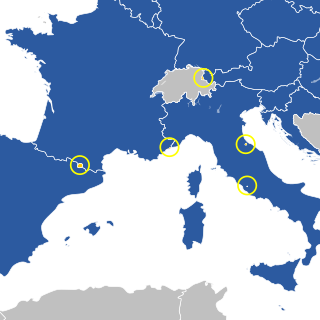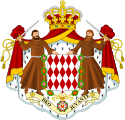
A customs union is the principal area of robust formal agreement between the Principality of Andorra and the European Union (EU). Andorra borders two EU member states: France and Spain.

Serbian passports are issued to Serbian citizens at any age, and it is the primary document of international travel issued by Serbia.

The visa policy of the Schengen Area is set by the European Union and applies to the Schengen Area and to other EU member states except Ireland. The visa policy allows nationals of certain countries to enter the Schengen Area via air, land or sea without a visa for stays of up to 90 days within a 180-day period. Nationals of certain other countries are required to have a visa either upon arrival or in transit.

There are a number of microstates in Europe. While there is no clear consensus on which political units qualify as "microstates", most scholars view Andorra, Liechtenstein, Monaco, San Marino and the Vatican City as examples of such states. At the same time, some academics dispute even qualifying Vatican as a true state arguing that it does not meet the "traditional criteria of statehood" and that the "special status of the Vatican City is probably best regarded as a means of ensuring that the Pope can freely exercise his spiritual functions, and in this respect is loosely analogous to that of the headquarters of international organisations." According to the qualitative definition of microstates suggested by Dumienski (2014), microstates can also be viewed as "modern protected states, i.e. sovereign states that have been able to unilaterally depute certain attributes of sovereignty to larger powers in exchange for benign protection of their political and economic viability against their geographic or demographic constraints." And indeed, all of the European microstates are sovereign states that function in a close association with their respective larger neighbour. Currently, all of the European microstates have some form of relations with the European Union (EU).

A passport stamp is an inked impression in a passport typically made by rubber stamp upon entering or exiting a territory.

Armenian Passports are issued to Armenian citizens to travel outside Armenia. They are also used as proof of identity within the country, along with Armenian ID cards.

Dutch passports are issued to citizens of the Kingdom of the Netherlands for the purpose of international travel. As the Netherlands only distinguish one category of citizen, for all countries in the Kingdom, passports are the same for all four countries. The passport also serves as a means of identification as required by the Dutch law since 1 January 2005 for all persons over the age of fourteen. Dutch passports are valid for a period of ten years from issuing date. The passport complies with the rules for European Union passports. Since 26 August 2006 all passports are issued as a biometric passport with an embedded contactless smartcard RFID chip for storing biometric data. Every Dutch citizen is also a citizen of the European Union. The nationality allows for free rights of movement and residence in any of the states of the European Union, European Economic Area, and Switzerland.

The Schengen Area is an area comprising 26 European countries that have officially abolished all passport and all other types of border control at their mutual borders. The area mostly functions as a single jurisdiction for international travel purposes, with a common visa policy. The area is named after the 1985 Schengen Agreement signed in Schengen, Luxembourg.

Mexican visas are documents issued by the National Migration Institute, dependent on the Secretariat of the Interior, with the stated goal of regulating and facilitating migratory flows.

Visitors to Montenegro must obtain a visa from one of the Montenegrin diplomatic missions unless they come from one of the visa exempt countries. Visa policy is regulated by Regulation on Visa Regime Act. Where there are no diplomatic or consular representations of Montenegro, visa requiring foreigners may obtain them from diplomatic or consular representations of Serbia, Bulgaria and Croatia.

Visa requirements for Indonesian citizens are administrative entry restrictions imposed on citizens of Indonesia by the authorities of other states. As of January 2020, Indonesian citizens had visa-free or visa on arrival access to 71 countries and territories, ranking the Indonesian passport 73rd in terms of travel freedom according to the Henley Passport Index. Indonesia is also a part of ASEAN and has visa-free access to these countries and vice versa.

The Andorran government imposes no visa requirements on its visitors and only requires a passport or European Union national identity card for entrance. However, since the country is only accessible via the Schengen countries of Spain or France, entrance is not possible without entering the Schengen area first and the Schengen visa rules can therefore be regarded to apply de facto. Because Andorra is not part of the Schengen area, a multiple entry visa is required to re-enter the Schengen area when leaving Andorra. Foreign visitors looking to stay in Andorra more than 90 days require a residence permit.

The visa policy of Turkey deals with the requirements which a foreign national wishing to enter Turkey must meet to be permitted to travel to, enter and remain in the country.

A common visa exists since the end of 2010 for the territories of Aruba, Curaçao, Sint Maarten and the Caribbean Netherlands which form together the territory of the Kingdom of the Netherlands in the Caribbean. The visa is not valid for the European part of the Netherlands, which is part of the Schengen Area.
The gallery of passport stamps by country or territory contains an alphabetical list of sovereign states or dependent territories with images of their passport stamps including visas. All Schengen countries, Albania, Bulgaria, Croatia, Cyprus, Moldova, North Macedonia, Romania and Turkey use the same format for their stamps, and stamps are not issued while traveling from one Schengen country to the other.

San Marino is not a member of the European Union or European Economic Area. However, it maintains an open border with Italy. Since San Marino is only accessible via Italy entrance is not possible without entering the Schengen Area first and therefore Schengen visa rules apply de facto. Foreign visitors staying more than 10 days in San Marino must have a permit from the government.

Although the European portion of France is part of the Schengen Area, its overseas departments, collectivities and other territories apply their own visa policies, which have some additional exemptions or restrictions compared to the visa policy of the Schengen Area.

The British Overseas Territories (BOTs) maintain their own rules regarding immigration requirements different from the visa policy of the United Kingdom, but remain under its sovereignty. As a general rule, British citizen passport holders do not generally have automatic right of abode in these territories.

The Andorra–France border extends for 57 km (35 mi) in southern France and northern and north-eastern Andorra.

Passports of the EFTA member states are passports issued by the European Free Trade Association (EFTA) member states Iceland, Liechtenstein, Norway and Switzerland. EFTA is in this article used as a common name for these countries.




















